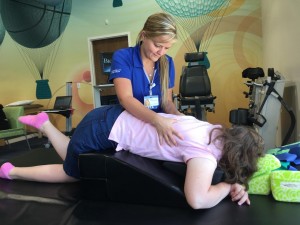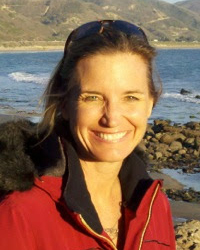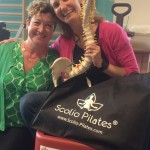Noveber 8, 2017
Pilates in the hospitals: Back where it all began
Scolio-Pilates® works with Dayton Children’s Hospital
By Karena Thek
In the early phases of his work, Joseph Pilates did a lot more than provide fitness instruction and athletic training. He was on the cutting edge of rehabilitation. Physical rehabilitation, up to the early twentieth century, was something that came with rest, not movement. Joseph Pilates was at the forefront of changing that paradigm when he used his movement techniques (Contrology) to rehabilitate wounded soldiers in a hospital where he was an orderly during the First World War. Later, in New York, while his work became known for its effectiveness in rehabilitating dancers, he also demonstrated his rehabilitative genius through his work with professional dancer, Eve Gentry. He helped her to recover from a radical mastectomy that removed most of her left pectoral muscle. His results gained the attention of Dr. Henry Jordan, Chief of Orthopedics at Lenox Hill Hospital. Dr. Jordan referred many patients to Joseph Pilates, but was unable to secure Pilates a position at Lenox Hill Hospital, possibly due to a lack of credentials.
I had just written Scolio-Pilates, Exercise for Scoliosis, A Pro-Active Guide and I was being interviewed by two orthopedic surgeons on a nationwide radio show about my new book. One of the doctors asked why I had written the book. I said that in addition to current management of scoliosis (observation, bracing and surgery), I was attempting to add a three-dimensional exercise program for assisting in the management of scoliosis. I wanted to add exercise to the offerings, not detract. I wanted patients to have a resource for feeling their very best while they were, first and foremost, following the advice of their medical team. The doctor leading the show stopped me. He told his listeners that exercise was not a viable option for scoliosis and ended my interview early.
Leaving my memory of that interview behind and coming back to the present, I saw my dad still looking at me over his glasses. He asked, “What was that phone call all about?” I said, “I think there’s a children’s hospital that wants to talk about having a Scolio-Pilates program at their hospital.” My dad looked confused and asked, “What? Why?” I explained it would be a three-dimensional exercise program for patients with scoliosis. My dad said, “Well, but why are they calling you? Isn’t there anyone else who does what you do?” We both laughed. Well … actually there aren’t a lot of people that do what I do, but I told my dad, “Trust me. We are trying to change that.”
Once the ball got rolling at Dayton Children’s, the vice-president and chief of ambulatory care, Ben Goodstein kept the momentum going and has become a colleague with formidable presence and tremendous support by authorizing the Scolio-Pilates program at Dayton Children’s. But it was Ann Smith DPT, MS, OSC and manager of the Orthopedics Physical Therapy department who had a vision of what this would mean for her patients and possibly for the future of managing scoliosis. She has managed the details of the program in her physical therapy department and has a vision for Scolio-Pilates that includes a 5-year longitudinal study.
To get the program started, my first visit to Dayton Children’s was in July. I came in for meetings with the doctors and medical teams to introduce the Scolio-Pilates program. I also spent the weekend leading their physical therapy team through the Scolio-Pilates Introductory course. By the way, I spent this whole weekend asking myself, “Is this real?” Is Scolio-Pilates really going to be part of a children’s hospital?” It really was so hard to imagine.

 Karena Thek is a Pilates Instructor with a passion for managing pathologies in the Pilates setting as well as disseminating information for those who are ready to change. Her work has led her to author OsteoPilates, Increase Bone Density, Reduce Fracture Risk, Look and Feel Great! (2003) and Scolio-Pilates, Exercise for Scoliosis, A Pro-Active Guide (2011). In addition to her books, she has numerous webinars and free YouTube videos on the topics that she teaches. Karena is the host of a women’s health talk radio show, Alive & Well Radio on AM1220 KHTS. You can listen live from anywhere on the planet at www.hometownstation.com. She previously hosted Pilates for Healthy Bodies on PBS (2009-2011). And when she’s not teaching, writing or thinking about Pilates? You can find her on Facebook and Twitter posting pics of daily adventures with her partner John and their furry little child, Gus T. Basset Hound. Learn more at osteopilates.com
Karena Thek is a Pilates Instructor with a passion for managing pathologies in the Pilates setting as well as disseminating information for those who are ready to change. Her work has led her to author OsteoPilates, Increase Bone Density, Reduce Fracture Risk, Look and Feel Great! (2003) and Scolio-Pilates, Exercise for Scoliosis, A Pro-Active Guide (2011). In addition to her books, she has numerous webinars and free YouTube videos on the topics that she teaches. Karena is the host of a women’s health talk radio show, Alive & Well Radio on AM1220 KHTS. You can listen live from anywhere on the planet at www.hometownstation.com. She previously hosted Pilates for Healthy Bodies on PBS (2009-2011). And when she’s not teaching, writing or thinking about Pilates? You can find her on Facebook and Twitter posting pics of daily adventures with her partner John and their furry little child, Gus T. Basset Hound. Learn more at osteopilates.com

